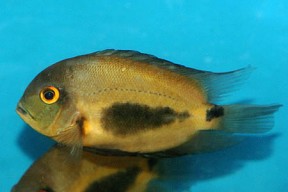Uaru amphiacanthoides
Uaru
Classification
Cichlidae. Subfamily: Cichlasomatinae
Distribution
Native to parts of the Amazon basin in northern Brazil and Guyana. It occurs both in the middle to lower Rio Negro, as well as between the Rio Japurá and Rio Tapajós along the Rio Solimões and main Amazon river.
Habitat
Found in clear water tributaries, often around submerged branches or tree roots.
Maximum Standard Length
10″ to 12″ wild fish can reach 14″
Aquarium SizeTop ↑
For a pair 48″ x 18″ x 15″ (120cm x 45cm x 37.5cm) 200 litres..
Maintenance
A large roomy aquarium with a sand or gravel substrate and decorated with bogwood and roots is preferred. Leave unplanted as most aquatic plants will be eaten.
Water Conditions
Temperature: 82 to 86f (27 – 30°C)
pH: pH 6 to 7
Hardness: Soft – upto 5°dH
Diet
Stomach analyses of wild fish have revealed it to be an omnivore existing on a substantial amount of plant matter along with an assortment of invertebrates and even freshwater sponges. However experiments with captive fish suggest it’s primarily herbivorous
Behaviour and CompatibilityTop ↑
Suprisingly peaceful for such a large cichlid. Can be safely housed with smaller fish such as tetras. Ideal tankmates include Angels (altum and scalare), heros, geophagus, satanoperca and the larger characins (headstanders,prochilodus,metynnis).Any tank mates should be able to handle the higher tempratures uaru require.
Sexual Dimorphism
These fish are not sexually dimorphic
Reproduction
Wild caught Uaru will require water paramaters that mirror their natural habitat(very soft and acidic). Captive bred fish will be less fussy. Spawning accures on a flat rock or peice of bogwood.
Young Uaru will readily feed off the parent fishes’ slime coat, in a manner much the same as Discus.
NotesTop ↑
A large, peaceful South American cichlid. Uaru can make very interesting aquarium subjects.
They require clean, well filtered water on the higher end of the temprature scale.
Avoid keeping with overly aggressive fish, Uaru are happiest when kept in groups or pairs.



